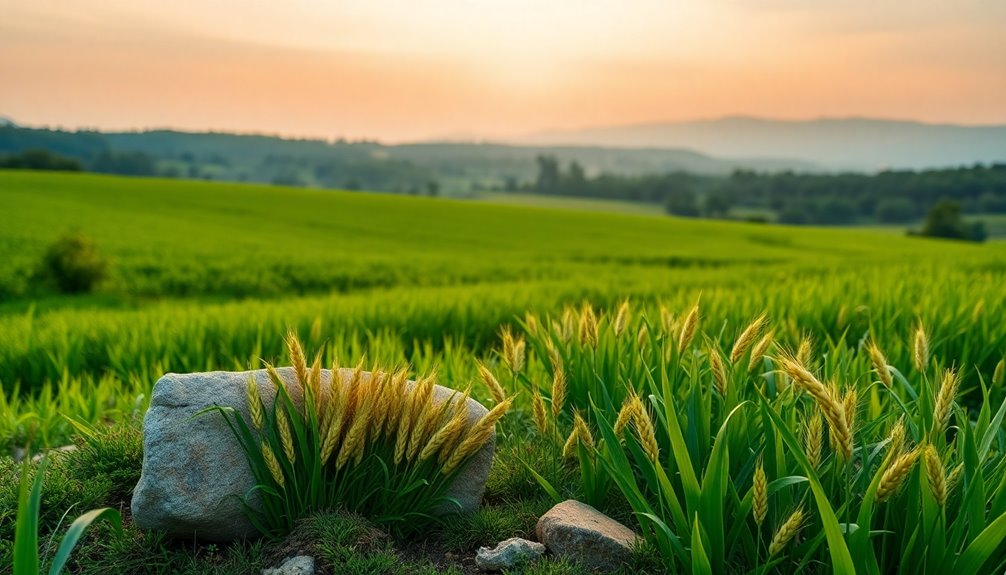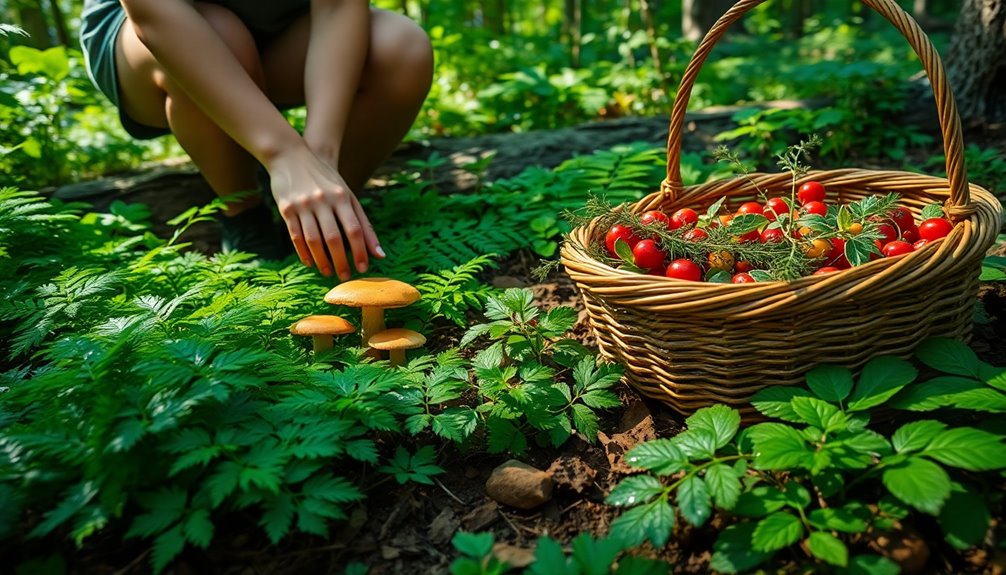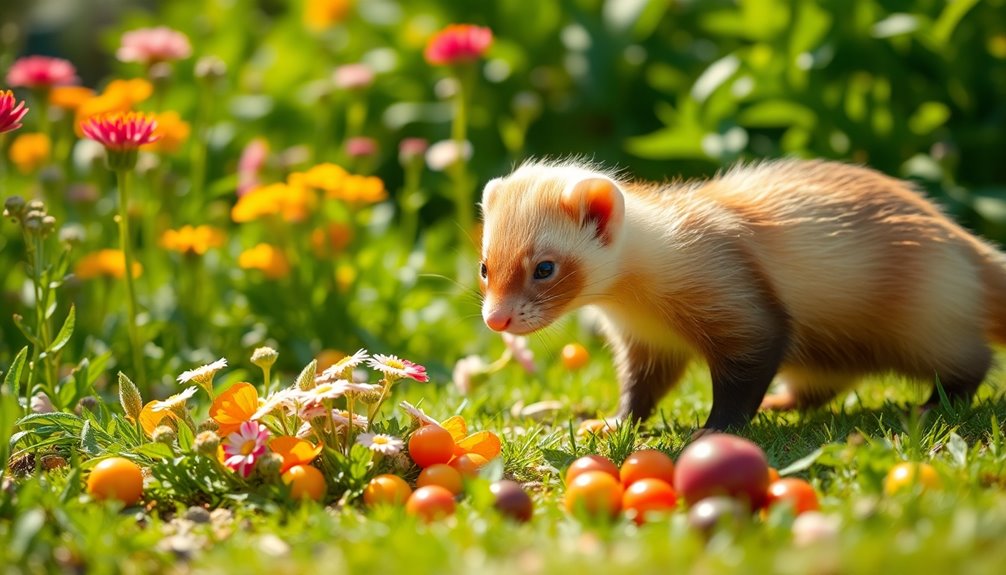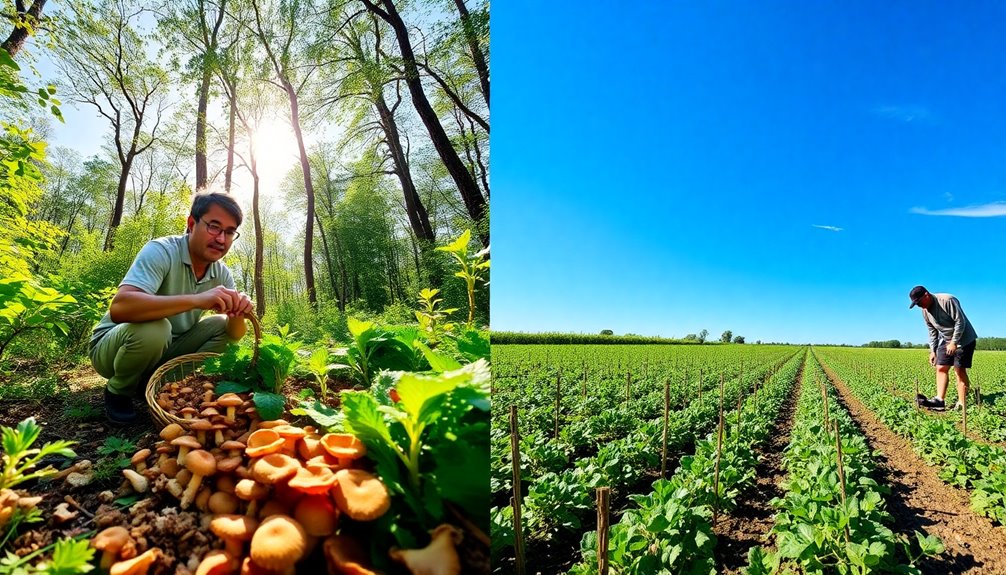The shift from foraging to farming happened due to several main factors. Environmental changes, especially after the last Ice Age, created warmer climates that boosted plant growth. As populations increased, competition for food intensified, driving communities to cultivate crops for stable supplies. The establishment of property rights allowed for resource defense, fostering settled lifestyles. Technological innovations, like irrigation and efficient tools, enhanced agricultural productivity. Together, these elements led to social changes, including job specialization and economic stratification. If you're curious about how these factors interconnect, there's even more to uncover.
Key Takeaways
- Environmental changes, particularly warmer temperatures and altered rainfall, promoted the growth of wild grains and encouraged the shift to agriculture.
- Population pressures and food scarcity drove communities to cultivate crops for stable food supplies, supporting larger populations.
- The establishment of property rights provided security for agricultural investments and fostered cooperation among settled communities.
- Technological innovations, such as irrigation and efficient harvesting tools, significantly improved agricultural productivity and resource management.
- The emergence of private property and surplus food accumulation led to social stratification and the development of complex community structures.
Overview of the Transition
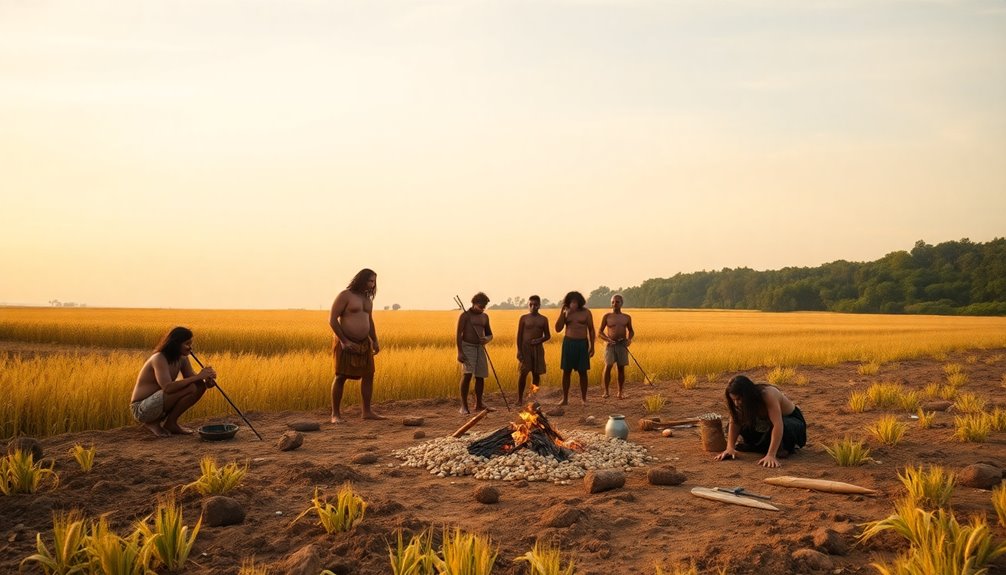
The change from foraging to farming, which began around 12,000 years ago, marked a pivotal shift in human history. This change from foraging to farming, often referred to as the agricultural revolution, unfolded across various regions, with the Fertile Crescent being one of the most notable. In this region, people began domesticating plants and animals, allowing for a more stable food supply.
Though early farming practices produced lower yields than foraged resources, they laid the groundwork for significant cultural evolution. As populations grew and climate changes created food shortages, the need for reliable food sources spurred this change. You might find it surprising that, initially, agriculture didn't offer the abundance people might expect; yields were often on par with gathered resources.
However, this new way of life fundamentally reshaped societal structures and resource management practices. The agricultural revolution led to the establishment of permanent settlements, altering social dynamics and paving the way for future civilizations.
Understanding this change helps you appreciate how deeply interconnected our agricultural roots are with the development of human society.
Environmental Changes
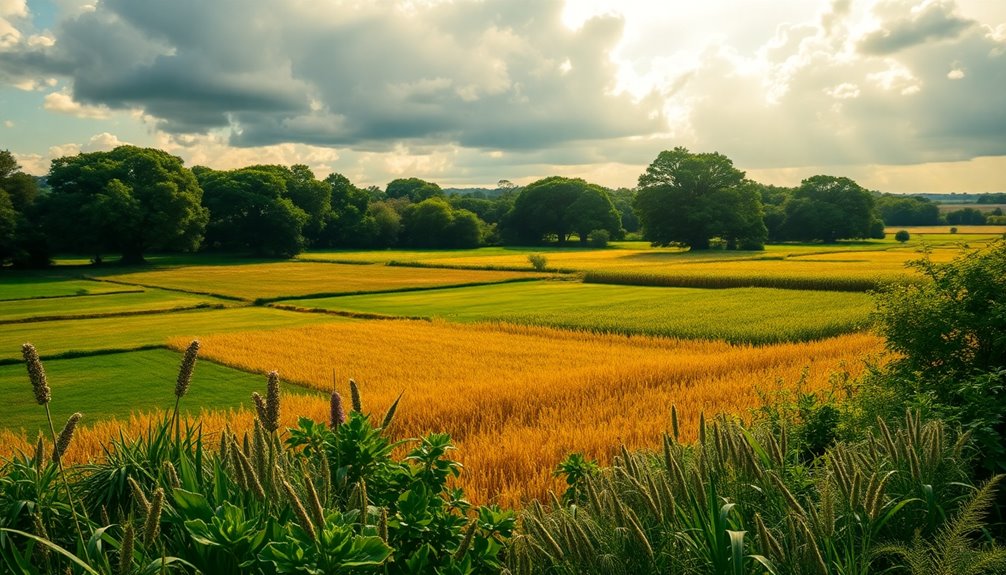
As the last Ice Age came to an end about 12,000 years ago, you'd notice significant shifts in climate that opened up new opportunities for early humans.
Warmer temperatures and changes in rainfall patterns created ideal conditions for plant growth, making farming more feasible.
This transformation in the environment directly influenced resource availability, setting the stage for the change from foraging to agriculture.
Climate Change Impact
Warm temperatures and shifting climates transformed landscapes and lifestyles, marking a critical turning point in human history. As the last Ice Age ended around 11,700 years ago, climate variability became a major factor influencing human decisions. You'll see how these changes prompted the shift from foraging to farming through various environmental impacts.
| Factor | Impact on Shift |
|---|---|
| Warmer Temperatures | Allowed diverse plant growth |
| Expansion of Fertile Crescent | Supported key crop domestication |
| Ecosystem Alterations | Facilitated animal domestication |
| Drought Periods | Increased need for stable food production |
Archaeological evidence shows that as climates shifted, communities began experimenting with cultivating wild grains. This gradual exploration laid the groundwork for systematic food production. The increased reliability of food sources from agriculture became essential for survival, particularly during periods of drought. Therefore, the interplay between climate change and human adaptability not only shaped agricultural practices but also transformed societal structures, ultimately leading to the rise of sedentary communities and complex civilizations. Additionally, the tiny house movement reflects modern adaptations to space and resource constraints, echoing the historical shift towards more sustainable living practices.
Resource Availability Shifts
Climate changes at the end of the last Ice Age reshaped landscapes and directly impacted resource availability, driving communities to seek more reliable food sources. Warming temperatures and altered precipitation patterns created ideal conditions for plant growth, prompting early farmers to shift from foraging to agriculture. The Fertile Crescent emerged as an essential region, boasting rich soil and diverse edible plants, making it an attractive area for farming communities.
As populations expanded, foraging resources dwindled, leading to food shortages. This scarcity pushed communities to adopt farming practices to guarantee a sustainable food supply. The domestication of wild grains like barley and wheat became feasible due to favorable ecosystem changes that allowed for easier harvesting and cultivation. Additionally, the demand for organic tea reflects a growing interest in sustainable agricultural practices, which can be traced back to these early farming innovations.
Archaeological evidence supports that the shift to farming was heavily influenced by the availability of suitable land and water resources. This encouraged the development of irrigation techniques that further enhanced crop production. Additionally, the presence of suitable storage techniques for harvested crops allowed communities to manage their food supplies more effectively.
Ultimately, the changes in resource availability not only transformed the landscape but also laid the foundation for the rise of agriculture, marking a significant turning point in human history.
Population Pressures
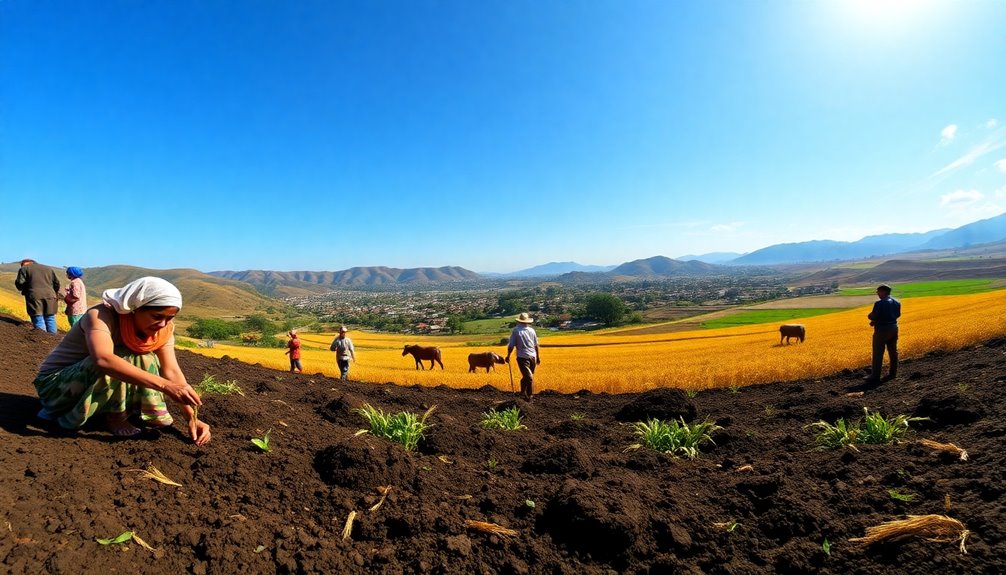
Population pressures played an essential role in the change from foraging to farming. As human communities expanded, the competition for food resources intensified. This led you and others to seek more reliable food sources, prompting the adoption of agricultural methods. It became clear that adapting to these pressures was necessary to thrive.
- Climatic changes often resulted in food scarcity, compelling groups to innovate.
- Limited wild food sources in fertile regions drove communities to settle and cultivate crops.
- The need for stable food supplies in growing populations fostered independent agricultural development worldwide.
As you moved from a nomadic lifestyle to settled farming communities, it allowed for better management of land and resources. This change was essential in supporting increasing population densities. Furthermore, the development of merchant services facilitated trade, enabling communities to exchange surplus crops and enhance their economic stability.
Archaeological evidence highlights that as hunter-gatherer populations grew, the limited availability of food became a significant driving force behind the move to agriculture. Ultimately, these population pressures not only shaped your lifestyle but also laid the groundwork for future civilizations, proving that adapting to resource limitations was crucial for survival.
Development of Agriculture
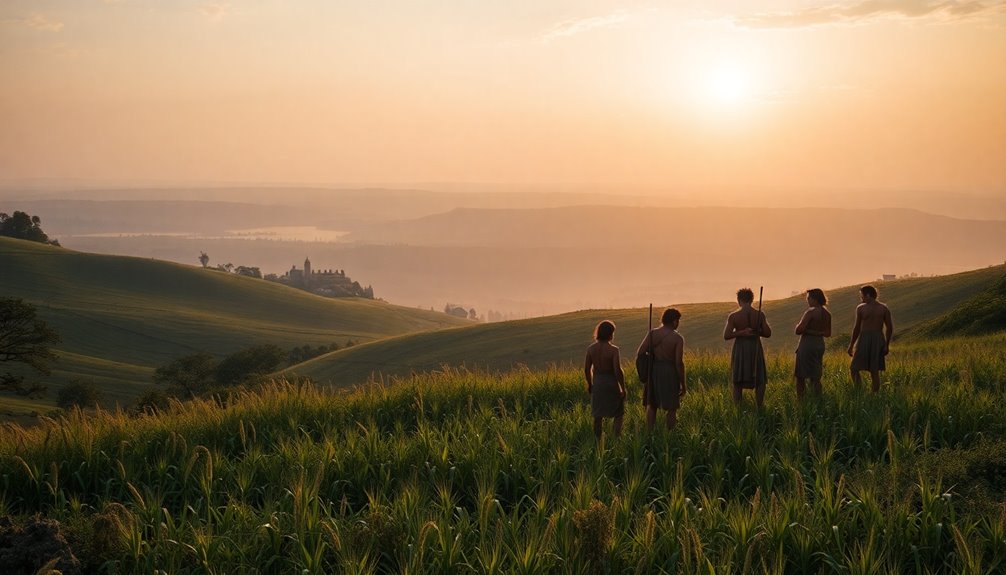
As communities sought stability in their food supply, the development of agriculture emerged as a transformative solution around 10,000 years ago. In regions like the Fertile Crescent, rich soil and favorable climates made it easier for you to cultivate crops and domesticate animals. This change from foraging to farming enabled societies to establish stable food sources, moving away from nomadic lifestyles.
Initially, early agricultural practices struggled with lower productivity compared to foraging, meaning you didn't necessarily gather more calories for the same amount of labor. However, advancements in technology, such as sickle blades and granaries, improved crop production and resource management. These innovations supported the establishment of permanent settlements and allowed for more complex social organization.
As climate change and population pressures mounted, including food shortages, you and your community increasingly turned to agriculture for sustenance. The need for reliable food sources catalyzed this change, paving the way for the development of property rights. Additionally, the shift to agriculture enhanced vibrational alignment with community well-being and stability, fostering social cooperation and support.
With agriculture, you began to stake claim to land and resources, laying the groundwork for future societal structures and interactions.
Role of Property Rights
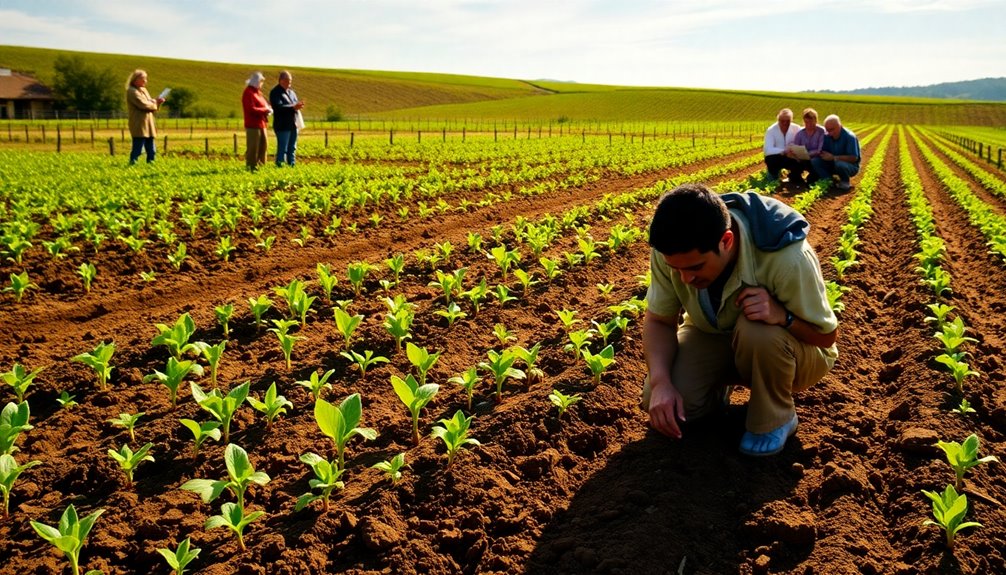
As you explore the shift from foraging to farming, consider how property rights played a vital role in defending resources.
When communities established clear ownership, they not only protected their agricultural yields but also shaped their social structures.
This shift allowed for stronger cooperation and investment in land, fostering a more sustainable way of life.
Importance of Resource Defense
Establishing property rights played a pivotal role in the shift from foraging to farming, enabling communities to defend their agricultural resources effectively. With defined ownership, individuals felt secure in investing time and effort into their crops, knowing they could protect their yields from competing groups.
The importance of resource defense manifested in several ways:
- Enhanced security: Clearly defined property rights motivated individuals to cultivate and protect their land, leading to increased agricultural productivity.
- Social structure development: As communities settled, they formed social norms around resource defense, prioritizing the protection of agricultural assets.
- Co-evolution with agriculture: Areas like the Fertile Crescent saw property rights and farming practices evolve together, fostering cooperation and shared management of resources.
In essence, the establishment of property rights not only facilitated the progression to agriculture but also shaped the very fabric of emerging societies.
These rights provided the foundation for a more organized approach to resource defense, ensuring that surpluses could be secured and maintained. As a result, communities could thrive and grow, moving away from a nomadic lifestyle toward one rooted in agriculture.
Impact on Community Structure
The establishment of property rights greatly reshaped community structures, paving the way for more organized social systems. As farming emerged, defined property rights became essential for safeguarding agricultural products, transforming small groups into structured societies. In contrast to hunter-gatherers, these communities fostered a sense of ownership, which greatly impacted their social dynamics.
| Factor | Impact on Community Structure |
|---|---|
| Emergence of Private Property | Facilitated accumulation of surplus food |
| Economic Stratification | Led to the development of social hierarchies |
| Conflict Resolution | Strengthened land use management |
| Support for Agriculture | Encouraged stability and growth |
With the growth of these communities, the need for property rights intensified, as disputes over resources became more common. This shift allowed for the emergence of social hierarchies, as individuals could accumulate wealth and influence based on their property holdings. Consequently, property rights not only defined the landscape of agriculture but also restructured the very fabric of community life, paving the way for complex social organizations and cultural evolution.
Social Organization Shifts
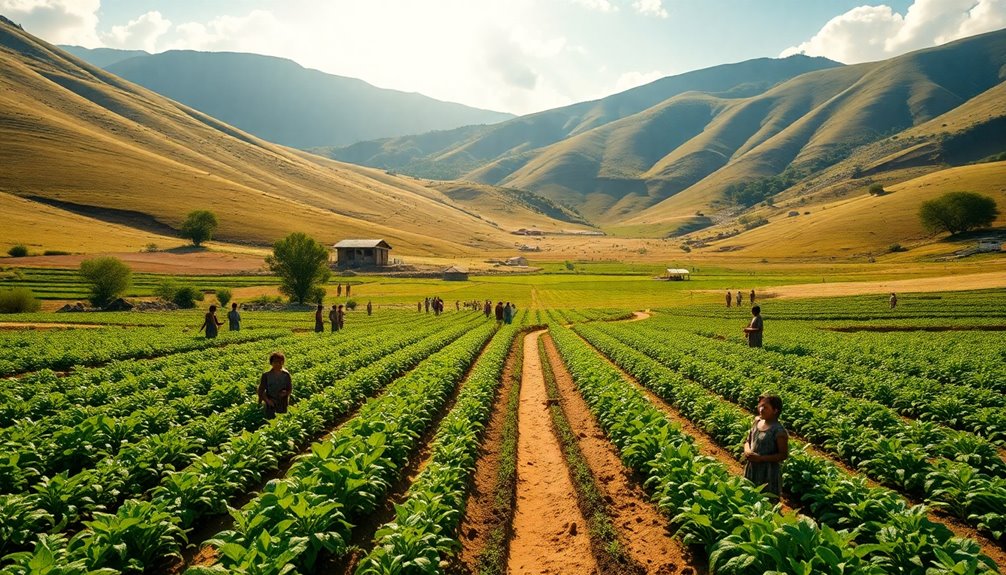
With the shift from foraging to farming, social organizations transformed dramatically. Settled communities emerged, allowing for job specialization and the establishment of social hierarchies based on wealth and land ownership. This transformation brought about significant changes in how people interacted and organized themselves.
- Economic stratification led to distinct classes, such as wealthy landowners and sharecroppers, altering social dynamics.
- Increased interaction within close living quarters fostered complex relationships, necessitating new governance structures.
- Changes in property rights became essential, as communities developed legal frameworks to protect and manage agricultural resources.
As surplus food became available, these social hierarchies solidified, impacting everything from family structures to community governance.
The rise of agricultural societies also saw belief systems evolve from animism to polytheism, often reflecting the emerging social order.
You can see how these shifts didn't just change how people farmed; they also redefined their social fabric, creating a more stratified society. This new organization laid the groundwork for future civilizations, highlighting the profound impact of agricultural practices on social dynamics.
Technological Innovations
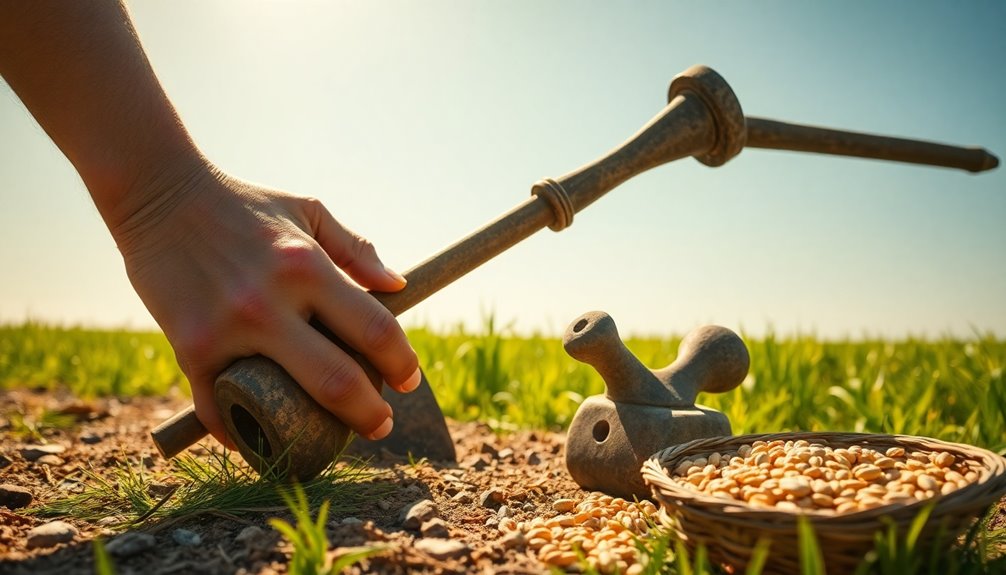
How did technological innovations reshape agricultural practices during the change from foraging to farming? You'll find that advancements played a vital role in this transformation.
The development of tools like sickle blades and grinding stones made harvesting and processing grains much more efficient, greatly boosting agricultural productivity. Furthermore, innovations in irrigation techniques, particularly in the Fertile Crescent, allowed you to manage water resources effectively, enabling the cultivation of crops even in arid regions.
The domestication of plants and animals marked a groundbreaking technological milestone. It led to reliable food sources, fundamentally altering human lifestyles and settlement patterns. With domestication, you gained a consistent means of nourishment, reducing dependence on unpredictable foraging.
Another important advancement was the construction of granaries, which helped preserve surplus harvests, protecting them from pests and spoilage. Additionally, advances in pottery technology improved food storage and cooking methods, supporting the needs of settled agricultural communities.
Together, these technological advancements didn't just enhance food production; they shaped the very foundation of society, allowing you to thrive in a new agricultural era.
Frequently Asked Questions
Why Did We Switch From Foraging to Farming?
You switched from foraging to farming primarily for more reliable food sources.
As populations grew, you faced food shortages that pushed you to settle and cultivate crops. The changing climate also made certain areas more suitable for agriculture.
Although early farming had its challenges and health risks, the ability to control your food supply and establish property rights made farming a more appealing option for sustaining your community in the long run.
What Was the Transition From Foraging to Farming?
Imagine that around 10,000 years ago, only about 1% of the world's population practiced agriculture.
This shift from foraging to farming transformed human life dramatically. You shifted from a nomadic lifestyle, constantly searching for food, to establishing settled communities.
As you cultivated crops and domesticated animals, you created surplus food, allowing populations to grow and societies to become more complex.
This change laid the groundwork for civilization as you know it today.
Which Major Factor Caused Humans to Transition From Foraging to Agriculture Around the World?
You might find that climate change played a significant role in pushing humans toward agriculture. As temperatures rose and weather patterns shifted, foraging became less reliable, leading to food shortages.
This instability urged communities to cultivate plants and domesticate animals for a more steady food supply. By adopting farming practices, you'd see a shift toward permanent settlements and a more organized society, eventually transforming the way humans lived and interacted with their environment.
Why Did the Transition From Foraging to Farming Occurred in the Nile Valley?
Around 5000 BCE, the Nile Valley's population surged as food security improved, with archaeological evidence showing a shift from foraging to farming.
You'd see how the annual flooding deposited nutrient-rich silt, creating fertile land. This allowed you to cultivate crops like emmer wheat and barley, and raise livestock.
Plus, innovative irrigation techniques enhanced water management, supporting larger agricultural areas and laying the groundwork for complex societies and early Egyptian civilization.
Conclusion
In summary, the shift from foraging to farming was a monumental change driven by a mix of environmental changes, population pressures, and social evolution. You can see how the rise of agriculture transformed communities, sparking innovations that felt like fireworks lighting up the night sky. As people established property rights and new social structures emerged, the landscape of human life changed forever. This evolution not only fed growing populations but also laid the groundwork for modern civilization.

